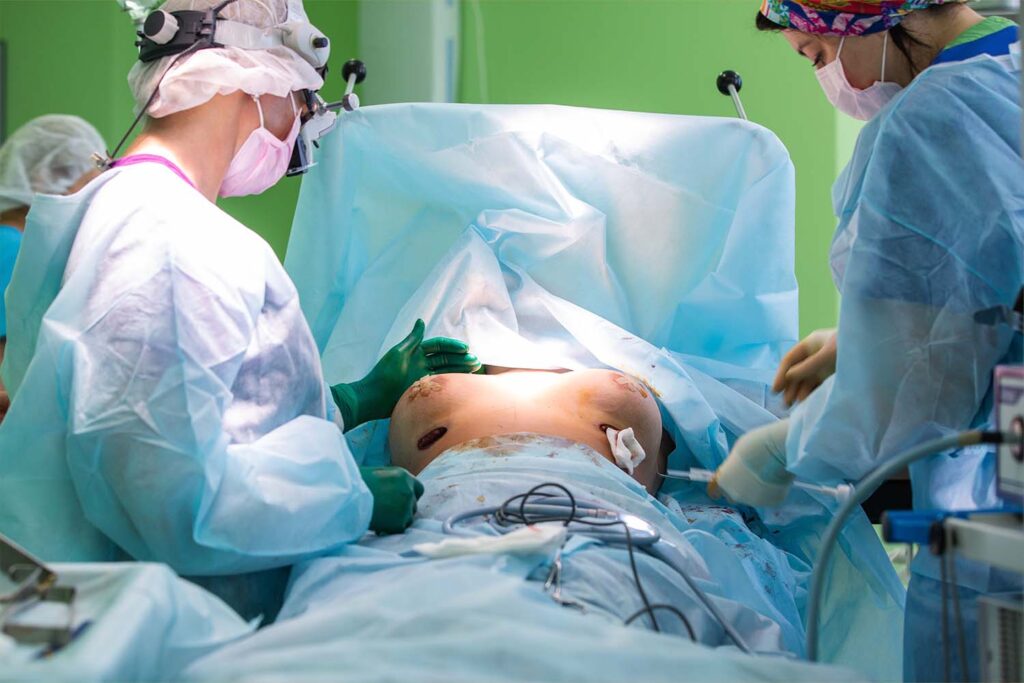Breast augmentation has been one of the most popular cosmetic surgeries for many decades. However, we’re now seeing more patients interested in nipple surgery.
Regarding the chest and breast area, the nipple and areola are typically where the eye goes first. While nipple deformities are most often painless, they can cause shame and embarrassment for some people who want a more aesthetically pleasing look to their chest.
Dr. Applebaum is a renowned plastic surgeon in southern California who has treated nearly every nipple deformity that exists.
What Should I Know About Nipple Surgery?
The nipple and areola are the smallest and most central anatomical areas of the chest.
Like other physical attributes, there are many reasons a patient could be unhappy with the size or shape of their nipples. Some features may be congenital or present since birth, whereas others are acquired over time stemming from developmental, hormonal, or medical factors.
Generally speaking, patients prefer their nipples and areolas to be proportionate and symmetrical with one another.
If you’re not happy with how your nipples or areolas look, several cosmetic procedures can be done to improve their appearance.
What Are the Different Types of Nipple Surgery?
Here we will review the types of aesthetic procedures to correct the nipple and areola. Other reconstructive techniques can be used to create a new nipple in cases of nipple absence, either from cancer removal or trauma.
Here are the most commonly requested aesthetic procedures for the nipple and areola:
Inverted Nipples
Inverted or retracted nipples occur when the nipples point inward below the skin surface and don’t protrude normally. This condition could present early on in childhood, during adolescence when the breasts develop, or later in adulthood.
This condition can exist regardless of breast size. For some women, inverted nipples result from the changes in breast tissue after breastfeeding. In rare cases, it can be caused by underlying breast cancer.
Nipple inversion can range from mild to severe, with level one being the least and level three being the most severe. In a mild case, the nipples are occasionally inverted, but they can become erect with stimulation. In more severe cases, the nipples are retracted below the areola surface and cannot protrude manually.
In most cases, Dr. Applebaum can correct inverted nipples with a technique that is done with a small incision close to the base of the nipple. Then he can create a platform to support the base of the nipple by stretching the fibrous bands holding it down.
Dr. Applebaum usually performs nipple inversion surgery as a standalone procedure, but it can be combined with other breast surgeries such as breast reduction or breast augmentation.
Results are immediate, and most patients experience full correction while maintaining complete nipple function.
Prominent Nipple Reduction
Nipple prominence, or nipple hypertrophy, is a condition where someone has unusually large nipples that may have a spherical shape. In some cases, the nipple might protrude 2cm or even more.
Men and women can be born with prominent nipples, regardless of breast size. However, women are more likely to develop the condition after pregnancy and breastfeeding. Enlarged, hanging, or downward-pointing nipples can happen due to repetitive suction while nursing.
Patients seeking nipple reduction are usually concerned about the prominence of the nipples, which can make them too conspicuous or visible through clothing. Nipple hypertrophy can also cause chafing or irritation from constant rubbing against clothing.
Dr. Applebaum can reduce nipple prominence through a relatively simple procedure that results in a smaller, less projected, and more attractive nipple. Irregular-shaped nipples can be surgically corrected to appear more round and symmetrical as well.
Nipple reduction may be performed as a standalone surgery or with another breast procedure such as breast reduction, breast lift, or breast augmentation.
When receiving nipple prominence surgery on its own, the procedure can usually be done under local anesthesia with a minimal recovery period. Most patients maintain full nipple sensation after surgery.
Supernumerary Nipples and Accessory Breast Tissue
Supernumerary nipples are a minor but somewhat common congenital malformation related to the breast tissue and nipples on the chest.
Developing extra breast tissue or extra nipples can occur in both men and women.
Accessory breast tissue or supernumerary nipples appear around the mammalian milk line, making a wide V-shape from the front of the armpits down the side of the chest and abdomen.
These small, circular, pigmented skin lesions may resemble a mole or other benign skin pigmentation. They can also develop as more noticeable masses under the skin due to hormones, especially during pregnancy or lactation.
Extra nipples and accessory breast tissue don’t require treatment, but they can be unsightly and embarrassing for some patients. In that case, surgical excision is the typical treatment and results in permanent removal of breast tissue and extra nipples or areolas.
Should I Have Nipple Surgery?
If you feel self-conscious about the size, shape, or placement of your nipples, you might be able to benefit from nipple surgery. Many of our patients have chosen to have nipple surgery to address the following issues:
- Nipples point inward
- Nipples are too long
- Nipples are too big
- Areola too large in diameter
- Asymmetrical nipples or areola
- Abnormally textured areola
- Stretched or damaged nipples
- Droopy or sagging nipples
Can a Man Have Nipple Surgery?
Absolutely! It’s common for men to have concerns about the size or shape of their nipples. Nipple surgery can be life-changing for men who are too embarrassed to go shirtless.
In most cases, having large areola or protruding nipples can be more problematic for men because they don’t have a barrier of a bra between their nipples and clothing.
Dr. Applebaum is highly experienced in the complexities of having nipple surgery for men versus women and how to achieve a natural and appealing look.
Will I Have Scars After Nipple Surgery?
Any surgical procedure that requires an incision will have some level of scarring. The good news is that the placement of the incisions for nipple surgery tends to heal very well and blend in with the texture and darker shade of the areola. In most cases, the scars are virtually invisible.
What Is the Recovery Time for Nipple Surgery?
The recovery process is unique for everyone, but performing nipple surgery as a standalone procedure typically results in a very quick recovery period.
The complication rates associated with nipple revision surgery are very low, and minimal postoperative care is required. Most patients can return to work within two or three days.
When nipple surgery is performed in conjunction with another breast surgery, the most complex procedure will determine the recovery time.
Am I a Good Candidate for Nipple Surgery?
The decision to undergo nipple surgery is a personal one. It’s important that a patient feels confident with their choice, both mentally and physically.
We generally recommend a patient be 18 years or older and done developing in the breasts before having nipple reduction surgery or nipple inversion surgery. The patient cannot be breastfeeding or expect to breastfeed during recovery.
Lastly, the patient should be in good health. Preferably a non-smoker or willing to quit for at least six weeks prior to surgery. If there are any chronic conditions, such as high blood pressure or diabetes, your general physician will need to be cleared for plastic surgery.
How Should I Choose a Plastic Surgeon?
Some patients do a great deal of research and go on several consultations, while others are happy to take a recommendation from family or friends.
Either way, always choose a surgeon that is board-certified in plastic surgery. The American Board of Plastic Surgery (ABPS) is the highest and most reliable certification.
Ask to see a portfolio of nipple surgeries they’ve done before. This will be helpful to see the kind of work they’re capable of and identify the results you’re going for.
What Should I Expect at My Consultation?
During your consultation, Dr. Applebaum will take the time to hear your concerns and expectations, evaluate your anatomy, and discuss your aesthetic goals to recommend the procedures that are likely to produce the desired result.
Summary
Nipples and areola play a huge role in the aesthetic appearance of the breast. If you are unhappy with the size, shape, or symmetry of your nipples, having nipple revision surgery can permanently correct their appearance.
Areola reduction surgery is a relatively simple procedure that will reduce the diameter of one or both of your areolas. The surgery can be done on its own or paired with a breast reduction, breast lift, or breast augmentation.
Nipple inversion surgery has a high success rate and a short recovery time but can positively affect your self-esteem for a lifetime.
Sources:
Cosmetic procedures for the nipples and areolas | American Board of Plastic Surgeons
Surgical Correction of Inverted Nipples | National Library of Medicine

